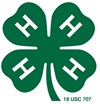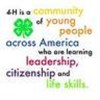I pledge my
my HEAD to clearer thinking,
my HEART to greater loyalty,
my HANDS to larger service,
and my HEALTH to better living
for my club, my community, my country and my world.
 |
||||
|
|
||||
|
|
4-H Member Resources
4-H Pledge
Posted 10/3/2012  I pledge my my HEAD to clearer thinking, my HEART to greater loyalty, my HANDS to larger service, and my HEALTH to better living for my club, my community, my country and my world.
The 4-H Symbols
Posted 10/3/2012  4-H Motto - “To Make the Best Better” 4-H Slogan - “Learning by Doing” 4-H Colors 4-H Club Emblem – A green four-leaf clover with a white “H” in each leaf 4-H members are encouraged to embrace the 4-H spirit expressed through these symbols and to live and wear it proudly in all they do and say.
The 4-H Club – What is it?
Posted 10/2/2012  A 4-H club consists of 5 or more school-age youth, guided by two or more adult volunteers. The 4-H Club’s goal is long-term youth development, which encourages its participants to learn life skills that will help them grow into healthy and productive citizens. A 4-H club is an informal, educational youth opportunity, which serves as a “hands-on” laboratory for helping youth grow in many ways. Download the PDF below to learn all about a 4-H club. Who are 4-H Volunteer Leaders?
Posted 10/2/2012  Several types of volunteer roles contribute to the leadership of the 4-H Club Program. All volunteers are offered and encouraged to pursue training opportunities throughout the 4-H program year. Organizational Leader - The organizational leader establishes and maintains a club structure that supports 4-H Youth Development activities for school age youth within a defined area. He/she works with the project leader, activity leader and youth in planning the club program; arranges for meeting facilities; complies with Cornell Cooperative Extension procedures; ensures that all enrollments, program registrations, completions, and reports are filled out and submitted to the county 4-H office in a timely manner; keeps the 4-H educator staff informed about activities, accomplishments and problems. An organizational leader may also act as a project leader. Project Leader - The project leader provides instruction and guidance to 4-H members when doing a project. The key component of the project leader’s role is teaching; the “classroom” is wherever the members meet in order to work on their project(s). Project leaders may also assist with project-related activities on the county level and guide members in the selection of projects and the completion of project reports. Activity Leader - The activity leader is responsible to help members plan for and participate in one or more specific activities the club has included in its yearly plan. These include such things as community service, public presentation, special celebrations, trips, etc. Resource Leader – Resource leaders are volunteers who are selected by Cooperative Extension staff to aid, train and work with 4-H club leaders or members on a short-term basis. They have a specialization in a certain program area and have undergone specialized training, sometimes leading to a certification. Resource leaders often teach workshops or serve as evaluators at fairs and contests. Some examples of resource leaders are: Master Sewer, Master Gardener or Master Food Preserver.
How Do I Become a 4-H Volunteer Leader?
Posted 10/2/2012  In New York State, adults with an interest in becoming a 4-H volunteer must complete an application process that includes an application form, interview, reference check, NYS Department of Motor Vehicle check, criminal background check and formal approval. Once approval has been granted, 4-H club organizational leaders participate in initial training. Quarterly meetings include educator staff and club organizational leaders. On occasions when the club organizational leader is unable to attend, an adult representative from the club may take his/her place at the meeting. At least one representative from each club is expected to attend each of the quarterly meetings.
How Do I Join 4-H?
Posted 10/1/2012  In Fulton and Montgomery Counties there are three different types of 4-H membership: 4-H Cloverbuds, 4-H Club Members and 4-H Independent Members. To join 4-H, choose among these options:
Contact Cornell Cooperative Extension of Fulton and Montgomery Counties if you reside in one of these counties. If you are a resident of a county other than Fulton or Montgomery Counties in New York State, contact your local Cooperative Extension office.
Which 4-H Membership is Right for Me?
Posted 10/1/2012  4-H Cloverbud Membership Generally ages 5 & in Kindergarten through grade 2, 4-H Cloverbuds are members of a group that generally meets once a week or twice a month for about an hour. 4-H Cloverbuds work on short term projects, usually spending two or three meetings on one topic, including related field trips whenever possible. 4-H Cloverbuds practice group decision making, individual skill building, and socialization with peers. 4-H Cloverbud clubs are led by at least two caring adults who plan projects, events and activities with input from the youth members. Leaders involve parents in activities at all levels. Competition is not permitted in the 4-H Cloverbud program in accordance with research, which has shown competition to be inappropriate at this age level. Most 4-H Cloverbud Clubs have between 5 (the minimum) and 10 members. 4-H Club Membership 4-H club members meet once a month for regular business meetings and attend project meetings in which they are enrolled at scheduled times throughout the year. Project offerings vary from club to club and year to year. Some clubs are focused on one major subject matter area, offering project work in related topics. Other clubs are general interest groups where members take projects from a wide variety of subject matter areas. All 4-H clubs plan and participate in community service projects and members learn first- hand about Parliamentary Procedure, increasing their decision making skills by participating in a monthly business meeting led by elected officers and following a set agenda. Most 4-H clubs have between 5 (the minimum) and 15 members. Larger 4-H clubs meet in church halls, firehouses, town halls or other community venue. Smaller clubs meet at the leader’s home or the homes of members. 4-H club members’ families are responsible for transportation to and from meetings, events and activities and for most costs incurred for the member’s own project materials. Research has shown that 4-H club membership improves school performance, a youth’s ability to make lasting friendships, and positively impacts their desire to make a difference in their communities. 4-H Independent Members 4-H independent members have the same rights and responsibilities as 4-H club members. 4-H independent members are guided by a parent/guardian or another caring adult arranged by the family. They obtain project teaching materials for their selected projects directly from the 4-H office and are responsible for securing supplies and equipment for all of their own projects. 4-H independent members plan and perform community service project work in their communities. 4-H independent membership is especially appealing to youth who have family or other commitments which preclude them from attending regularly scheduled business and project meetings.
Do I Have to Be an Enrolled 4-H Member to Participate in 4-H Activities?
Posted 10/1/2012 Yes, for most 4-H activities and events. On occasion there may a special opportunity for the public to join in a 4-H activity, but generally 4-H activities require prior enrollment.
What are My Responsibilities as a 4-H Member?
Posted 10/1/2012  4-H members are required to enroll in and complete at least one project, participate in the counties-wide 4-H fundraiser and submit a 4-H Member Record Book. 4-H members who fail to complete and submit a 4-H Member Record Book do not receive completion for the 4-H year. 4-H members are expected to respect adult leaders, fellow 4-H members and guests, and 4-H staff. They are also expected to attend club meetings, support club activities, and complete their 4-H project work and record book to the best of their ability. 4-H members are expected to respect and abide by local, state and federal laws, 4-H rules and regulations on the county, state and national level, respect and honor their club's rules and exhibit exemplary behavior during any 4-H activity. 4-H members are expected to exhibit fair competition and sportsmanship at all times. All 4-H members are required to read, sign and honor a "4-H Member Code of Conduct" during the enrollment process annually. Understanding 4-H Project Work
Posted 10/1/2012 A project is a planned series of learning activities/experiences that engage youth in the use of their heads and hands in ways that result in enhanced competencies, open hearts and better health. A 4-H project is a series of experiences, each activity building on the last one that produces growth in learning. 4-H teaching materials are research-based and curricula is tested, reviewed and recommended by a subject matter panels consisting of researchers, educators, volunteer leaders and youth. 4-H projects give youth opportunities to:
4-H projects teach the “why” as well as the “how.” For example: a member enrolled in a woodworking project might learn the safe and most effective way to use basic hand tools and gain experience in the selection of hardware and finishing materials while making a birdhouse (tangible product). The knowledge and skills learned (intangible product) can be applied when making other wooden items in the future. It is this transferable knowledge and skill that is the essence of the project—not just the finished product. A project will not always result in a tangible product but may lead solely to an intangible result (for example, learning a CPR technique). In either case a learn-by-doing approach is used. The 4-H “learning by doing” method involves several steps in a process: doing, and then thinking, planning, and often doing again. Such learning is called experiential learning (see the “Experiential Learning Model” on the next page) and is a powerful approach for young people to develop a variety of life skills. The experiential learning approach starts with a concrete activity—something for us to DO. Following the concrete activity we REFLECT on what we have experienced. Ask the members “what?” questions such as “What happened?” and “What was that like for you?” or “What did you observe?” Next we need to help the members generalize the concepts formed through this experience so that they can APPLY their learning to future real-life situations. To do this, we first ask “So what?” questions such as “So, what made it easier or harder for you?” and “So what are the key learning from this activity?". Finally, we ask, “Now what?” and “Now that I know this, what do I do next?” Through the experiential learning approach we help young people develop the characteristics and abilities that will allow them to grow into mature, productive and contributing citizens. In the 4-H Youth Development program, such characteristics and abilities are referred to as “Life Skills.” “Project skills” focus on mastery of skills to complete a tangible project, whereas “life skills” are important for youth development. As they apply to 4-H project work life skills:
As caring adults, we want to meet children’s needs. We want to help youth learn how to meet their own needs in positive ways and to develop life-long skills and competencies. This is the purpose of 4-H project work.
|
|||
Cornell Cooperative Extension of Fulton & Montgomery Counties provides equal program and employment opportunities. © 2025 Cornell Cooperative Extension of Fulton & Montgomery Counties. All rights reserved. |
||||